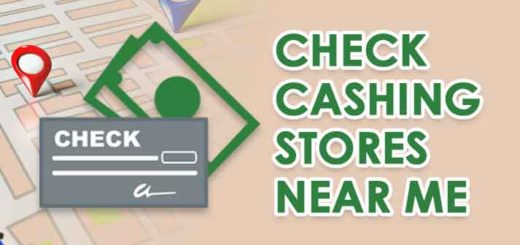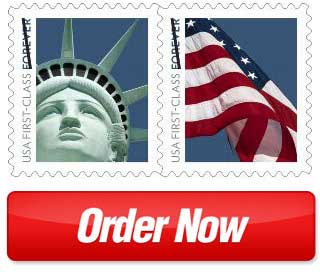A Colorful History of Postage Stamps – First US Postage Stamps
 A postage stamp is a small government issued sticker that is affixed to a piece of mail to prove payment for delivery services and cover the costs associated with delivering mail. Commonly stamps are manufactured on special paper with an adhesive on the back, depict a national symbol or historical figure and include the purchase value of the stamp called the denomination. Postage stamps can be purchased from a government post office (USPS) or select authorized retail vendors. In this article we will discuss the history of postage stamps and a few key inventions that impacted the industry in the US. Below you will find some of the key dates in US history that stamps were released and other dates that impacted the postal industry.
A postage stamp is a small government issued sticker that is affixed to a piece of mail to prove payment for delivery services and cover the costs associated with delivering mail. Commonly stamps are manufactured on special paper with an adhesive on the back, depict a national symbol or historical figure and include the purchase value of the stamp called the denomination. Postage stamps can be purchased from a government post office (USPS) or select authorized retail vendors. In this article we will discuss the history of postage stamps and a few key inventions that impacted the industry in the US. Below you will find some of the key dates in US history that stamps were released and other dates that impacted the postal industry.
Postage Stamps History in the US- Key Dates Timeline

History of American Postage Stamps – US postage stamps by year timeline
Postage Stamp History in the United States – A Brief Introduction
On July 1, 1847, the first postage stamp was issued in the United States by the Post Office Department and authorized by Congress. Prior to this monumental date, letters would be brought to a US Post office and the postmaster would write a note in the upper right hand corner of the envelope to signify that postage was paid.
Rates at that time were based off of how many sheets of paper were in the envelope and how far the letter needed to travel. At that time postage could be paid three different ways: by the sender, the receiver, or partially by both parties.
Before we get into the history of postage stamps in the United States, its important to know where and why they started…
How Did Postage Stamps Get Started
5 years before the first US postage stamp (1837), Great Britain’s Sir Rowland Hill suggested a standard delivery rate for any mail going to any destination in the British Isles. His idea was to establish a method of prepayment for envelopes that had postage rates printed on them or to use adhesive labels. Not only did he suggest charging paid-postage, but additionally to charge based upon the items weight.
This idea came about because prior to the stamp mail in the Britain was only paid for by the recipient. If the recipient refused to pay the postage then the cost of mailing was not recoverable by the British post office. Additionally since recipients paid the cost of postage, the sender had no motivation to restrict the size or weight of the package and it wouldn’t matter to them if the recipient refused payment.

First Postage Stamp. “Penny Black” May 6 1840 Great Britian
This lead to the invention of the “Penny Black” in May 6 1840 which is considered the first ever stamp. It cost one penny for a half ounce letter to be delivered to any destination in the British Isles. The Penny Black was adopted into all of Britain’s postal facilities. The stamp featured the image of Queen Victoria and the stamp sheets did not have perforations and had to be cut with scissors by postal clerks.
At their inception stamps were initially not required to feature the name of the issuing country. England today actually is the only country that does not feature their countries name on stamps.
The stamp was quickly recognized as an elegant and convenient solution for both mailers and post office workers. The solution allowed them to get costs paid for up front and ultimately deliver mail in a much more efficient postal system.
There are actually many different people prior to Sir Rowland Hill, that claim to have invented or theorized the first stamp including James Chalmers who had claimed he had the idea in 1834. Additionally there is some stamp history going back to the 1600’s.
The History of Postage Stamps in the US – The First Postage Stamp
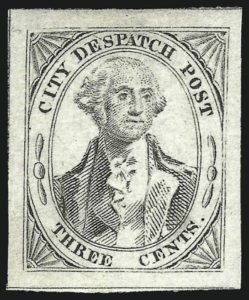
First US Postage Stamp Feb 1 1842, City Dispatch Post
On February 1, 1842 the first US postage stamps were issued. They were developed by a private carrier named Alexander M. Greig of the City Dispatch Post. The business of using adhesive stamps was purchased by The Post Office Department to incorporate the use of them into their business model. These stamps like all others of their era were rectangular in shape and featured political leaders.
In 1845, Postmasters’ Provisionals were created. These were special stamps that denoted prepayment of postage fees and were created by individual postmasters. Before 1845, this was not feasible, because postage stamp prices had not been standardized yet.
Two years after on March 3, 1847, Congress approved the official use of American postage stamps. The first city to issue the approved stamps was New York city and it all began just 60 days after the Congressional approval. There were two denominations approved for the first postage stamps: the five cent stamp featuring Benjamin Franklin and a ten cent stamp featuring George Washington. The stamps were printed on large sheets and postal clerks had to cut them out in order to sell them. It wasn’t until 1854, in England, that perforation of stamps began so that clerks would no longer have to cut the them out of sheets. It later caught on in the US with the first perforated stamp being issued on February 24, 1857 featuring George Washington in the history of postage stamps.
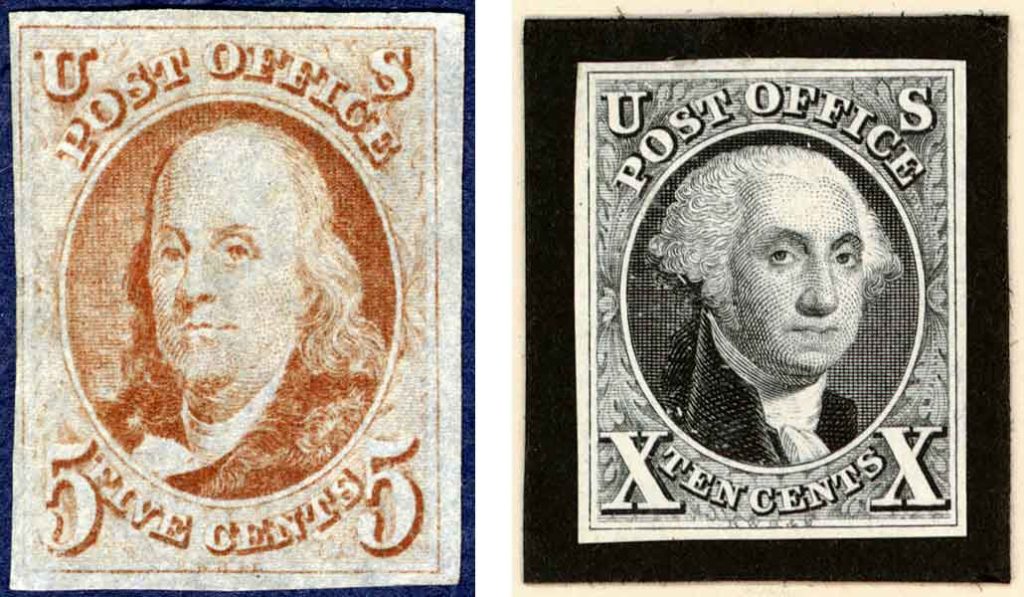
March 3, 1847 First Postage Stamps Approved by Congress- Five Cent Ben Franklin and 10 Cent George Washington
In 1856 the US purchased a rotary machine from England made to separate stamps. The machine cut the paper instead of separating the perforations, but it was later modified to do so.
For almost 10 years only Franklin and Washington appeared on stamps, until 1856 when a special five cent stamp was issued to pay homage to Thomas Jefferson. Up to this point in 1856 other methods of paying for postage were still considered legal. It was here that Congress declared postage the only acceptable form of currency for delivery. Later in 1863 a new denomination was introduced; the two cent stamp featuring Andrew Jackson, commonly referred to by collectors as the Black Jack. This also was the start of varying postage rates.
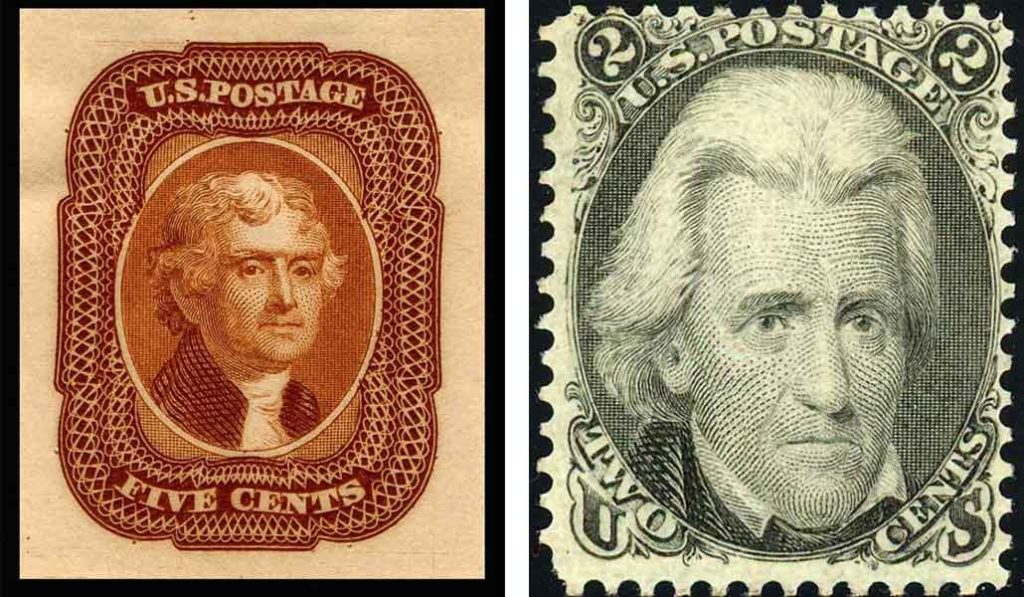
The 1856 Five Cent Thomas Jefferson and the 1863 Two Cent Andrew Jackson
Until 1869 only presidents and famous historical figures appeared on stamps. Then they issued stamps featuring trains and horses and many people were outraged by the change.
In the long history of postage stamps in America, no one has made more appearances than George Washington.
As stamps grew in their popularity and became more sophisticated in the engraved imagery collectors and historians began saving stamps. The study of stamps is referred to as philately.
History of Postal Stationery in America
On July 1, 1853 the first printed envelops with pre-marked postage were issued in America. These were not manufactured by the government, but instead by independent contractors who would charge for the cost of postage and the cost of manufacturing.
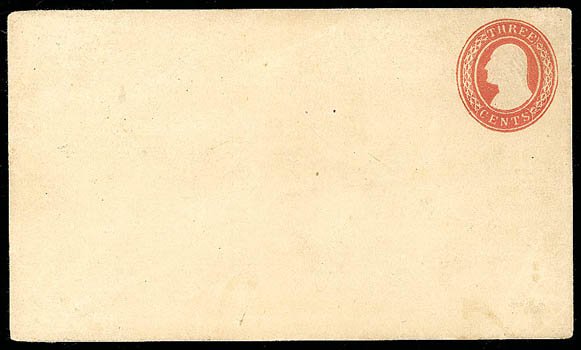
Postal Staionery 1853 to 1855
What stands out about postal stationery is the inclusion of the watermark. In 1853 watermarks were deemed mandatory by the government for any paper goods. These watermarks helped identify the manufacturer and authenticity and normally would change every 4 years to help prevent fraud.
The first pre-printed postage cards, also known as stamped cards, were in issued in Austria in 1869. Later these cards followed in the United States in 1873. These were produced directly by the government. Stamped cards differ from post cards, in that a stamped card has pre-printed postage on it, a post card which is privately printed does not have any postage on it.
These Stamped cards remained only the cost of postage for almost 150 years, when in January of 1999 the US Postal Service added the additional manufacturing costs to the cost of postage.
History of Pitney Bowes and the Stamp Machine
You can’t talk about the history of postage stamps with acknowledging the contributions of Pitney Bowes.
In 1902 Arthur Pitney created a postage-stamping machine. For 12 years the company worked on improving it’s functionality and ultimately trying to get financial backing from the US Postal service. The machine solved a growing problem for the post office, as mail volume was increasing the practicality of using adhesive stamps was diminishing.
The Pitney stamping machine allowed for mail to be tracked back to the source and kept tabs on the amount if postage. Additionally the stamp machine decreased labor costs for both the postal service and businesses that wanted to use it. While the machines proved to be an immediate success in 1914 it was not approved for production until the end of World War I.
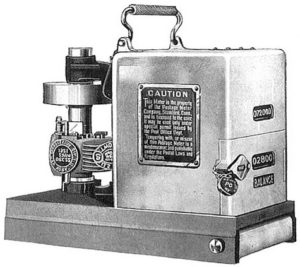
Piteny Bowes Model M Machine
At the same point in time Walter Bowes invented the Universal Stamping Machine which was an automatic stamp canceler. Cleverly Bowes did not sell the stamp cancelling machines to the US Post office, instead they rented them. Eventually he began renting machines to Germany, Canada, and England.
Pitney and Bowes eventually merged companies in April of 1920. Just after the completion of the merger they were able to pass congressional legislation to permit all classes of mail to be posted by meter instead of stamp. This led to the postal service officially licensing the Pitney Bowes machines. For more information on Pitney Bowes and how they contributed to the history of postage stamps you can read their story here.
History of US Commemorative Stamps
The first commemorative stamps issued in the United States occurred in 1893; They depicted a tribute to Columbus’s voyages to the New World. The size of these stamps were almost double the size (7/8 inches high by 1-11/32 inches wide ) of a normal postage stamp. The reason is so that is could feature a more artsy representation of paintings depicting the voyages of Christopher Columbus.
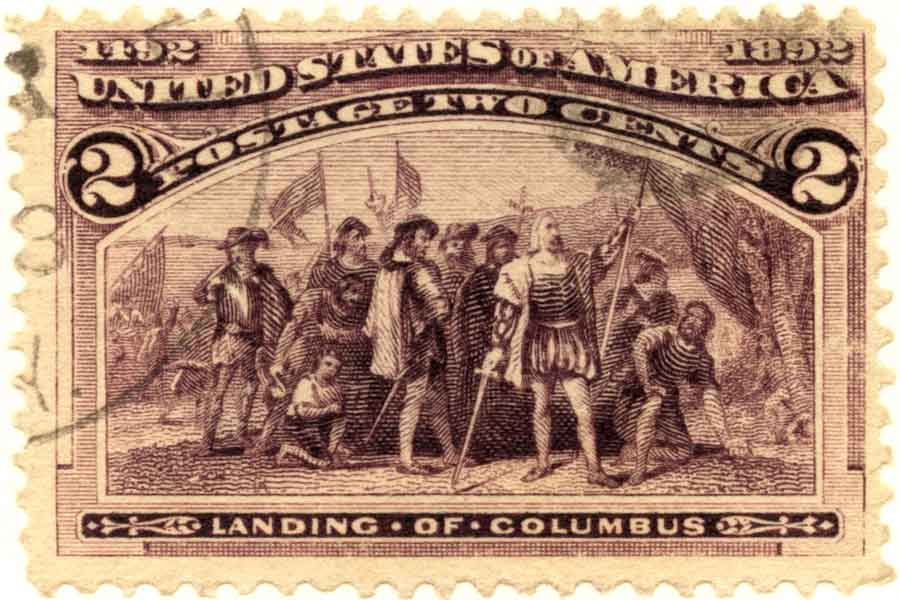
1893 First US Commemorative Stamp – Landing of Columbus
Since the inception of commemorative postage these have become popular amongst collectors and stamp enthusiasts. Many of these stamps come in odd sizes and shapes including a triangular stamp in 1997 and a circular stamp in the year 2000. In the history of postage stamps, no art work is quite like that featured on commemorative stamps.
Notable Features on Commemorative Stamps
Martha Washington was the first woman featured on a postage stamp in 1902. Admiral David Farragut was the first Hispanic American featured in 1903. Pocahontas was the first Native American featured on a stamp in 1907. Native Americans had been depicted on postage before, but Pocahontas was the first specific Native American person. Booker T. Washington was the first African American featured on postage in 1940.
The popular Elvis Presley stamp in 1993 came about at the result of a vote by the public. People were encouraged to choose a younger or older version of “The King”. The younger version of Elvis won the challenge and to date it is still the top selling US commemorative stamp of all time in the history of postage stamps.
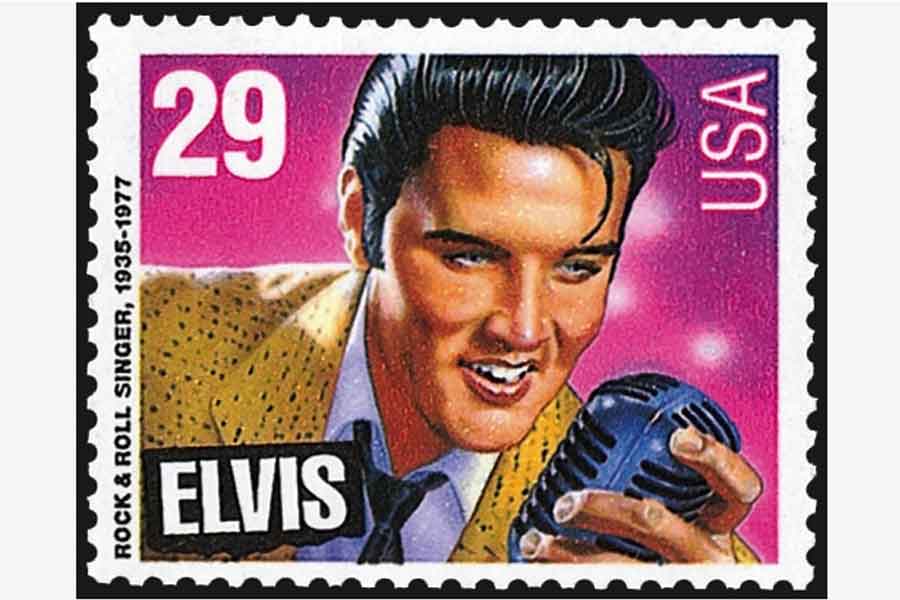
1993 Elvis Presley Commemorative Stamp – Best Selling Commemorative Stamp of All Time
History of Postage Stamps – Stamp Books
April 16, 1900 was the first time stamps were sold in books. Books are bundles of stamps, were you purchase them in bulk, but at the same rate of postage. There were 3 types of stamp books issued in 1900 12, 24, and 48 stamps. Each book contained two cent US postage stamps.
Because these stamps had adhesive on them parafinned paper was inserted in between the sheets of stamps to prevent them from sticking to each other. They also had a thin cardboard cover to protect them and postage rates were printed and displayed on the outside of the cardboard.
Today postage stamp books remain a key product for the United States Postal Service and are sold in non-postal retail stores such as grocery stores and pharmacies.
History of Postage Stamps – Coils and Vending Machines
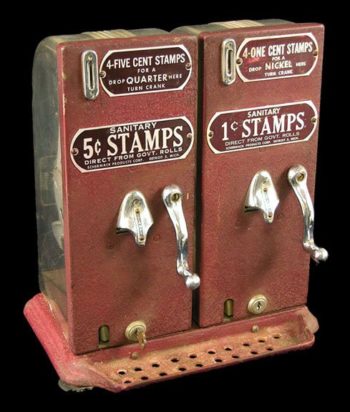
Antique Schermack Stamp Vending Machine
February 18, 1908 was the introduction of the first American stamp coil. Coils are large rolls of postage stamps often contacting more than 100 stamps in a roll. These were much easier for businesses to use because they could quickly dispense them for sending out large mailings.
Additionally these coils could be used inside Schermack Stamp Vending Machines. The Post Office wanted to feature self-service machines that sold and distributed stamps. Originally these machines were featured in the lobby of post offices in order to accommodate faster service and the ability to purchase stamps at any hours of the day, Later the Post Office tested distributing these machines at newsstands, stores, train stations, and hotels.
In modern times these vending machines are now fully automated computerized self service kiosks located in the lobby of USPS post offices.
The First US Nondenominational Stamps
Nondenominational stamps are postage without a specific value listed on it. The first nondenominational stamps were issued in 1975 and depicted the Christmas holiday. These stamps came into existence because a rate change was requested from 10 cents to 13 cents and the decision from the Postal Rate Commission was delayed. The Postal Service decided not to wait for a decision and sold the stamps for 10 cents each.

1978 Nondenominational Stamp
Similarly in 1978, nondenominational stamps were printed because there was concern about a stamp shortage. These nondenominational stamps featured just the letter “A” and were sold for domestic use only at 15 cents a piece.
Since this time there have been nondenominational stamps printed with the letters A through H. These were often done up to 1998 when postage rate changes were taking effect. Up to this point that is the only time nondenominational stamps were printed in the United States.
Non denominational stamps in today’s market are common place and are called Forever stamps which came about in 2006.
The History of Self-Adhesive Stamps
In December of 1974 the USPS first tested self-adhesive pre-canceled stamps. Pre-canceled means that there is a mark across the face of the stamp to prove purchase and eliminate the possibility of reusing the postage. The self-adhesive stamps were originally invented to add more security to pre-cancelation with the idea being it would harder to reuse.
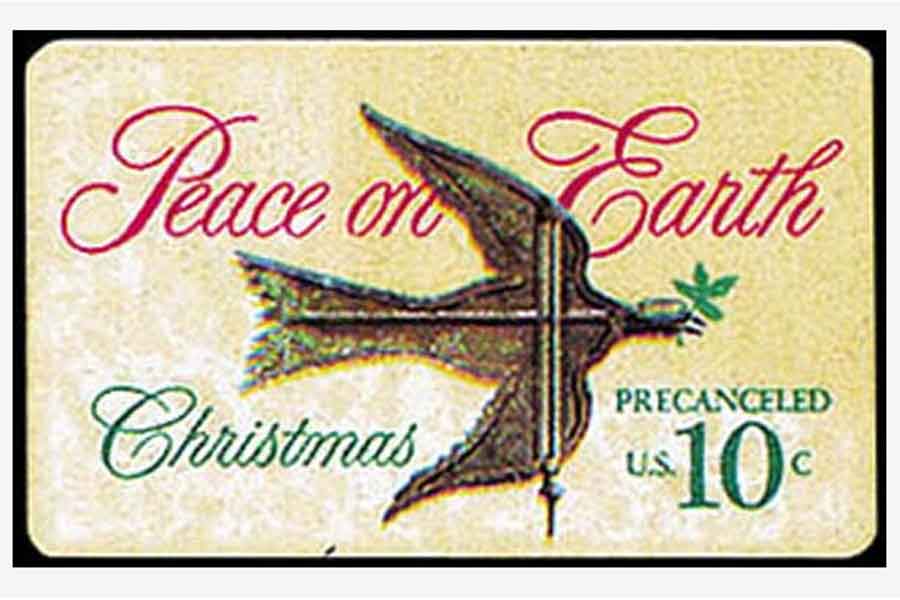
1974 First Pre-Canceled Self-Adhesive Stamp – Peace on Earth
Pre canceled stamps were already being sold, but not with self-adhesive. It was actually thought that in the 1960’s almost 20% of all pre canceled stamps were reused by soaking off the cancelation ink marking. The idea of adding self-adhesive was to eliminate the stamps from being soaked. Additionally to prevent the reuse the self-adhesive’s featured tiny slits so that if your tried to peel it off an envelope the stamp would come apart.
The downside to all of the innovation to prevent reuse was the cost to manufacture a standard stamp increased by almost five times the cost of postage. Not only that, but it was found the pre-cancellation could still be soaked off and reused.
In 1989 the USPS re-experimented with self-adhesives this time with a focus on ease of use for their customers. They utilized a new self-adhesive formula and placed on coated paper. This prevented the stamps from being destroyed when you peel them off. In 1992 they officially issued the new self-adhesive postage stamps. These are the same types you find in books, coils, and collector sheets today.
History of United States Semipostals
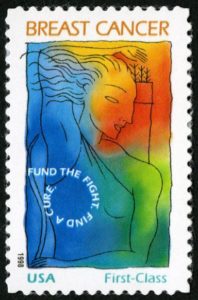
1998 First Semipostal Stamp – Breast Cancer Research
Semipostals are stamps that cost more than the actual price of postage. These are dedicated to specific causes or research were the proceeds are donated to help fund a particular cause. These are an important contribution in the history of postage stamps in the US because of their societal impact.
The first semipostal stamp was issued in 1998 and was dedicated to Breast Cancer Research. The second was the Heroes of 2001 issued in 2002 were the proceeds were donated to families of emergency workers killed or injured in the September 11, 2001 attacks. The Third semipostal was the Stop Family Violence stamp issued in 2003 with proceeds to benefit the stop to domestic violence charities. Semipostals are still very popular today.
Over the history of American postage stamps there have been many more Semipostals and they sell very well because people rally around good causes. One stands out though, the 1998 Breast Cancer stamp has sold over one billion stamps to date and has raised over $81 million dollars for Breast Cancer research.
History of Forever Stamps

Nondenominational Forever Stamp
The first Forever stamps were issued in 2007 and featured a picture of the Liberty bell. These are nondenominational stamps that honor the price you pay for them today no matter if the cost of postage increases in the future. One Forever stamp will cover the postage for the first ounce of a First Class piece of mail.
Forever stamps are the most popular form of postage used today and are generally what you find in USPS kiosks and non-postal retail stores.
Despite the fact stamps have been around for over 150 years the first class stamp is still affordable and provides a tremendous value when you consider the technology and logistics that are involved in delivering mail today.
History of Postage Stamps in the United States
There is a rich history of postage stamps in the United States that tell the story of a growing nation. If you look at stamps over the last 150 years, you can see what was going during that era, get a sense of printing technology, and understand how little cost has inflated over that span of time. Additionally stamps have gone from an item exclusively sold by USPS to being able to purchase stamps at popular retail stores and online. More exclusive rare stamps can be found by contacting stamp dealers. To learn more about the history of stamps and see some of the rarest postage stamps in existence, you can also check out local stamp shows.
